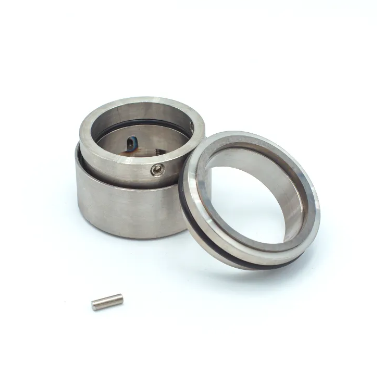Understanding agitator seal Failures and Repair Costs
Common Causes of Agitator Seal Failure
Agitator seal failures can occur due to a variety of reasons, each impacting the operational effectiveness of industrial processes. Material degradation, often exacerbated by continuous use, leads to wear and tear, compromising seal integrity over time. Thermal expansion is another critical factor, where changes in temperature cause expansion or contraction, adversely affecting seal function. Moreover, operational overload, due to excessive pressure or misalignment, can exert undue stress, resulting in seal failure. Environmental conditions, such as fluctuating temperatures and chemical exposure, significantly influence seal durability. For instance, in high-temperature operations or corrosive chemical environments, seals are prone to rapid deterioration. Research indicates that material degradation contributes to nearly 30% of seal failures, emphasizing the need for durable materials in seal design. Meanwhile, thermal expansion accounts for approximately 25% of such failures, underscoring that temperature control is crucial. By recognizing these causes, industries can implement preventive measures to mitigate seal failures effectively.
Key Factors Affecting Repair Costs
The cost of repairing agitator seals can vary widely due to several influencing factors. Primarily, the type of seal plays a crucial role; simple designs are typically more affordable to repair than specialized configurations requiring custom parts. The complexity of repair significantly impacts the labor cost, as intricate repairs necessitate highly skilled technicians. Availability of parts also dictates expenses, with rare components often fetching premium prices. Labor costs further influence the total repair bill, where skilled technician rates can vary across service providers. For instance, according to an industry report, standard repair costs can range from $500 to $2,000, depending on the complexity and parts required. When comparing service providers, it's noticeable that specialized contracts might cost more due to superior expertise but offer long-term savings through improved reliability and reduced downtime. Understanding these cost factors allows businesses to budget efficiently for maintenance and select appropriate service contracts.
Step-by-Step Agitator Seal Repair Process
Inspection and Disassembly Best Practices
Inspecting a failed agitator seal is a crucial first step in the repair process. A structured inspection can help identify the extent of damage and the causes leading to failure, such as material wear or improper handling. To ensure precision, employing methods from industry standards—such as visual examination and non-destructive testing—are advisable. During disassembly, it is vital to utilize the correct tools to avoid further component damage. Expert maintenance manuals often recommend using specialized wrenches and alignment tools, which minimize the risk of distortion. By following these best practices, the likelihood of successful troubleshooting and repair increases significantly.
Cleaning and Component Replacement Guidelines
Effective cleaning of seal components is essential to ensure optimal performance post-repair. Thoroughly removing residues such as dust, oil, and other contaminants from the seal enhances its ability to function properly. Utilizing industry-recommended cleaning solvents and methods preserves the integrity of the seal material. When it comes to component replacement, this is where the precision of material choice becomes vital. Components like gaskets and O-rings should be replaced with high-quality materials that match or exceed the original specifications. Technical guidelines suggest choosing materials that stand up to operational demands, such as high temperatures and chemical exposure, fostering a longer lifespan for the seal.
Reassembly Techniques for Optimal Performance
Proper reassembly of an agitator seal is indispensable for ensuring its longevity and functionality. By following a structured assembly process, technicians can minimize common pitfalls like misalignment or improper torquing. Critical steps include carefully aligning all components, adhering to torque specifications, and performing thorough alignment checks. These practices not only avert potential leaks but also enhance the overall operational efficiency of the equipment. It's crucial to continuously refer to maintenance documentation or manuals during reassembly to avoid mistakes that could compromise the seal's effectiveness. This meticulous approach ensures that the repaired seal can reliably perform under demanding conditions.
Repair vs. Replacement: Making the Right Choice
Signs Your Seal Can Be Repaired Cost-Effectively
Determining when to repair a seal rather than replace it hinges on several indicators, suggesting the seal is still viable for repair. First, minor wear and initial failure signs such as small chips and surface scratches on the seal can often be managed with a professional repair, making it a cost-effective solution. In terms of cost analysis, repairing an agitator seal is usually less expensive in the short term compared to replacement, especially when dealing with high-quality custom seals. Industry standards suggest that if the primary components of the seal are structurally sound and only minor repairs are necessary, then repair is a viable and economical choice.
When Replacement Becomes the Better Investment
Certain scenarios make replacement a more prudent choice than repair. Key among these are instances of critical failure or excessive wear, like cracks or warps in the seal that impair its functionality. Over the long term, replacing old seals with newer, efficient technology can prove more beneficial by eliminating issues and enhancing performance. Data supports that new seals often provide enhancements such as improved efficiency and reduced maintenance needs, making them a wise financial investment over time. If repetitive failures occur or if the equipment is outdated, updating to a newer seal design could result in better performance and fewer disruptions.
Preventive Strategies to Extend Seal Lifespan
To proactively guard against seal failures and extend their lifespan, I emphasize the importance of preventive maintenance. Regular inspections can detect early signs of wear, allowing for timely replacements of worn components before they escalate into bigger issues. Moreover, employing high-quality materials and ensuring proper installation methods are critical in minimizing wear and tear. These strategies not only prolong the life of the seals but also improve the overall efficiency of the equipment. For instance, according to Flexaseal, using seals with specialty fillers like antimony or engineered resins can significantly enhance performance while reducing wear. Case studies within the industry consistently highlight that proactive maintenance programs not only decrease downtime but also yield substantial cost savings over time.
Choosing a Qualified Repair Service Provider
Selecting a qualified service provider is essential when engaging in agitation seal repair. When considering options, I look for certifications that validate the provider's expertise, scrutinize their industry experience, and review customer testimonials to gauge reliability. An often overlooked component is the importance of service warranty and post-repair support, which can be crucial for addressing future issues and ensuring peace of mind. It's reported that companies with robust service warranties boast improved equipment longevity and reduced failure rates. As industry data suggests, opting for a reputable service provider correlates strongly with the enhanced operational lifecycle of equipment. This selection process ensures that my seals are maintained by knowledgeable professionals, who are capable of maintaining the seals' integrity and efficiency.
FAQ
Q: What are the main causes of agitator seal failure?
A: The main causes include material degradation, thermal expansion, operational overload, and adverse environmental conditions such as chemical exposure and fluctuating temperatures.
Q: How can I control repair costs for agitator seals?
A: Repair costs can be controlled by considering the type of seal, complexity of the repair, availability of parts, and labor costs. It is also helpful to compare service provider prices and expertise.
Q: What's the advantage of repairing a seal over replacing it?
A: Repairing a seal can be more cost-effective, especially if the damage is minor. It is usually less expensive in the short term compared to replacement, especially for high-quality custom seals.
Q: When should I consider replacing an agitator seal?
A: Consider replacement in cases of critical failure, excessive wear, or when the seal's technology is outdated. Newer seals often offer better performance and reduced maintenance.
Q: What preventive measures can extend the lifespan of agitator seals?
A: Regular inspections, using high-quality materials, and proper installation methods can minimize wear and tear and prolong the seal longevity.
Table of Contents
-
Understanding agitator seal Failures and Repair Costs
- Common Causes of Agitator Seal Failure
- Key Factors Affecting Repair Costs
- Step-by-Step Agitator Seal Repair Process
- Inspection and Disassembly Best Practices
- Cleaning and Component Replacement Guidelines
- Reassembly Techniques for Optimal Performance
- Repair vs. Replacement: Making the Right Choice
- Signs Your Seal Can Be Repaired Cost-Effectively
- When Replacement Becomes the Better Investment
- Preventive Strategies to Extend Seal Lifespan
- Choosing a Qualified Repair Service Provider
- FAQ


